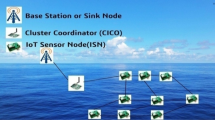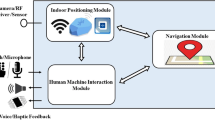Abstract
Generally, in Visible Light Communication (VLC) systems, Position Sensitive Device (PSD) sensor is used only for tracking purposes. However, the tracking process functions until both transmitter and receiver align, thus the PSD sensor remains idle for a long time. This interval can be exploited to achieve other functions by modifying its architecture. In this paper, a modification of the PSD structure has been achieved to make it able to perform energy harvesting and data acquisition as well as tracking. As the PSD is mainly formed of an array of photodiodes, our main idea is to use transistors to switch between the two modes of operation of the photodiodes (photoconductive and photovoltaic). Furthermore, switching between the output pins could be achieved depending on the desired function. The proposed sensor can extend the battery lifetime, increase the integration and the functionality, and reduce the physical size of the system. Simulation using MATALB was performed to validate the concept of the proposed structure and its operation. The results showed that the proposed sensor works successfully and it can be considered for further manufacturing levels. The presented sensor might be used in Free Space Optical (FSO) communication like cube satellite, or even in Underwater Wireless Optical Communication (UWOC).








Similar content being viewed by others
REFERENCES
Wei, Z., Wang, L., Li, Z., Chen, C.J., Wu, M.C., Wang, L., and Fu, H.Y., Micro-LEDs illuminate visible light communication, IEEE Communication Magazine, 2022, pp. 1–7. https://doi.org/10.1109/MCOM.002.2200109
Ndjiongue, A.R., Ferreira, H.C., and Ngatched, T.M., Visible light communications (VLC) technology, Wiley Encyclopedia of Electrical and Electronics Engineering, 1999, pp. 1–15.
Kumar, N., Lourenco, N., Spiez, M., and Aguiar, R.L., Visible light communication systems conception and vidas, IETE Tech. Rev., 2008, vol. 25, no. 6, pp. 359–367.
Cevik, T. and Yilmaz, S., An overview of visible light communication systems, Int. J. Comput. Networks Commun. (IJCNC), 2015, vol. 7, no. 6, pp. 139–150.
Liu, Z., Guan, W., and Wen, S., Improved target signal source tracking and extraction method based on outdoor visible light communication using an improved particle filter algorithm based on Cam-Shift algorithm, IEEE Photonics J., 2019, vol. 11, no. 6, pp. 1–20.
Do, T.H. and Yoo, M., An in-depth survey of visible light communication based positioning systems, Sensors, 2016, vol. 16, no. 5, p. 678.
Othman, A. and Maga, D., Indoor photovoltaic energy harvester with rechargeable battery for wireless sensor node, in 2018 18th International Conference on Mechatronics-Mechatronika (ME), IEEE, pp. 1–6.
Burchardt, H., Serafimovski, N., Tsonev, D., Videv, S., and Haas, H., VLC: Beyond point-to-point communication, IEEE Commun. Mag., 2014, vol. 52, no. 7, pp. 98–105.
Luo, J., Fan, L., and Li, H., Indoor positioning systems based on visible light communication: State of the art, IEEE Commun. Surv. Tutorials, 2017, vol. 19 no. 4, pp. 2871–2893.
Albayati, S., An overview of visible light communication systems, Int. J. Comput. Sci. Mobile Comput., 2019, vol. 8, no. 6, pp. 51–56.
Obeed, M., Salhab, A.M., Alouini, M.S., and Zummo, S.A., On optimizing VLC networks for downlink multi-user transmission: A survey, IEEE Commun. Surv. Tutorials, 2019, vol. 21, no. 3, pp. 2947–2976.
Ge, P., Liang, X., Wang, J., Zhao, C., Gao, X., and Ding, Z., Optical filter designs for multi-color visible light communication, IEEE Trans. Commun., 2018, vol. 67, no. 3, pp. 2173–2187.
Tedeschi, P., Sciancalepore, S., and Di Pietro, R., Security in energy harvesting networks: A survey of current solutions and research challenges, IEEE Commun. Surv. Tutorials, 2020, vol. 22, no. 4, pp. 2658–2693.
Blinowski, G., Security of visible light communication systems –A survey, Phys. Commun., 2019, vol. 34, pp. 246–260.
Wainwright, M., Maisch, T., Nonell, S., Plaetzer, K., Almeida, A., Tegos, G.P., and Hamblin, M.R., Photoantimicrobials—Are we afraid of the light?, Lancet Infect. Dis., 2017, vol. 17, no. 2, pp. e49–e55.
Căilean, A.M., and Dimian, M., Current challenges for visible light communications usage in vehicle applications: A survey, IEEE Commun. Surv. Tutorials, 2017, vol. 19, no. 4, pp. 2681–2703.
Sheoran, S., Garg, P., and Sharma, P.K., Location tracking for indoor VLC systems using intelligent photodiode receiver, IET Commun., 2018, vol. 12, no. 13, pp. 1589–1594.
Kaymak, Y., Rojas-Cessa, R., Feng, J., Ansari, N., Zhou, M., and Zhang, T., A survey on acquisition, tracking, and pointing mechanisms for mobile free-space optical communications, IEEE Commun. Surv. Tutorials, 2018, vol. 20, no. 2, pp. 1104–1123.
Kong, M., Kang, C.H., Alkhazragi, O., Sun, X., Guo, Y., Sait, M., Holguin-Lerma, J.A., Ng, T.K., and Ooi, B.S., Survey of energy-autonomous solar cell receivers for satellite–air–ground–ocean optical wireless communication, Prog. Quant. Electronics, 2020, vol. 74, p. 100300.
Khan, A.S. and Khan, F.U., A survey of wearable energy harvesting systems, Int. J. Energy Res., 2022, vol. 46, no. 3, pp. 2277–2329.
Kiziroglou, M.E. and Yeatman, E.M., Materials and techniques for energy harvesting, Functional Materials for Sustainable Energy Applications, Woodhead Publ., 2012, pp. 541–572.
Chirap, A., Popa, V., Coca, E., and Potorac, D.A., A study on light energy harvesting from indoor environment: The autonomous sensor nodes, in 2014 International Conference on Development and Application Systems (DAS), IEEE, 2014, pp. 127–131.
Choudhary, P., Bhargava, L., Singh, V., Choudhary, M., and kumar Suhag, A., A survey – Energy harvesting sources and techniques for internet of things devices, Mater. Today: Proc., 2020, vol. 30, no. 1, pp. 52–56.
Dziadak, B., Makowski, Ł. and Michalski, A., Survey of energy harvesting systems for wireless sensor networks in environmental monitoring, Metrol. Meas. Syst., 2016, vol. 23, no. 4, pp. 495–512.
Fish, A., Hamami, S., and Yadid-Pecht, O., Self-powered active pixel sensors for ultra-low-power applications, IEEE Int. Symposium on Circuits and Systems, IEEE, 2005, pp. 5310–5313.
Liao, M., Koide, Y., and Alvarez, J., Single Schottky-barrier photodiode with interdigitated-finger geometry: Application to diamond, Appl. Phys. Lett., 2007, vol. 90, no. 12, pp. 123507.
Ruan, C., Zhao, W., Zhu, S.L., Liu, H.J., Yang, H.C., and Ruan, C.L., Characterization of photoconductive semiconductor switches under nonlinear mode condition, Microwave Opt. Technol. Lett., 2009, vol. 51, no. 1, pp. 56–59.
Cemine, V.J., Sarmiento, R., and Blanca, C.M., High-resolution mapping of the energy conversion efficiency of solar cells and silicon photodiodes in photovoltaic mode, Opt. Commun., 2008, vol. 281, no. 22, pp. 5580–5587.
Wei, Y., Lehmann, T., Silvestri, L., Wang, H., and Ladouceur, F., Photodiode working in zero-mode: detecting light power change with DC rejection and AC amplification, Opt. Express, 2021, vol. 29, no. 12, pp. 18915–18931.
Soon, J.J. and Low, K.S., Optimizing photovoltaic model parameters for simulation, in 2012 IEEE Int. Symposium on Industrial Electronics, IEEE, 2012, pp. 1813–1818.
Bader, S., Ma, X., and Oelmann, B., One-diode photovoltaic model parameters at indoor illumination levels – A comparison, Sol. Energy, 2019, vol. 180, pp. 707–716.
da Costa, W.T., Fardin, J.F., Simonetti, D.S., and de VBM Neto, L., Identification of photovoltaic model parameters by differential evolution, in 2010 IEEE Int. Conference on Industrial Technology, IEEE, 2010, pp. 931–936.
Ahmed, M.T., Gonçalves, T., and Tlemcani, M., Single diode model parameters analysis of photovoltaic cell, in 2016 IEEE Int. Conference on Renewable Energy Research and Applications (ICRERA), IEEE, 2016, pp. 396–400.
Dwik, S. and Somasundaram, N., Modeling and simulation of two-dimensional position sensitive detector (PSD) sensor, Int. J. Innovative Technol. Explor. Eng. (IJITEE), 2019, vol. 9, no. 1, pp. 744–753.
Ivan, I.A., Ardeleanu, M., and Laurent, G.J., High dynamics and precision optical measurement using a position sensitive detector (PSD) in reflection-mode: Application to 2D object tracking over a smart surface, Sensors, 2012, vol. 12, no. 12, pp. 16771–16784.
Heweage, M.F., Wen, X., and Eldamarawy, A., Developing laser spot position determination circuit modeling and measurements with a quad detector, Int. J. Model. Optim., 2016, vol. 6, no. 6, pp. 310–316.
Kim, S.M. and Won, J.S., Simultaneous reception of visible light communication and optical energy using a solar cell receiver, in 2013 Int. Conference on ICT Convergence (ICTC), IEEE, 2013, pp. 896–897.
Wang, Z., Tsonev, D., Videv, S., and Haas, H., On the design of a solar-panel receiver for optical wireless communications with simultaneous energy harvesting, IEEE J. Sel. Areas Commun., 2015, vol. 33, no. 8, pp. 1612–1623.
Fakidis, J., Videv, S., Helmers, H., and Haas, H., 0.5-Gb/s OFDM-based laser data and power transfer using a GaAs photovoltaic cell, IEEE Photonics Technol. Lett., 2018, vol. 30, no. 9, pp. 841–844.
Wang, H.Y., Wu, J.T., Chow, C.W., Liu, Y., Yeh, C.H., Liao, X.L., Lin, K.H., Wu, W.L., and Chen, Y.Y., Using pre-distorted PAM-4 signal and parallel resistance circuit to enhance the passive solar cell based visible light communication, Opt. Commun., 2018, vol. 407, pp. 245–249.
Kong, M., Lin, J., Guo, Y., Sun, X., Sait, M., Alkhazragi, O., Kang, C.H., Holguin-Lerma, J.A., Kheireddine, M., Ouhssain, M., and Jones, B.H., AquaE-lite hybrid-solar-cell receiver-modality for energy-autonomous terrestrial and underwater Internet-of-Things, IEEE Photonics J., 2020, vol. 12, no. 4, pp. 1–13.
Dwik, S. and Prabhaker, M.L.C., Survey on energy harvesting CMOS sensor based digital camera, Opt. Mem. Neural Networks, 2022, vol. 31, no. 1, pp. 97–106.
Nayar, S.K., Sims, D.C., and Fridberg, M., Towards self-powered cameras, 2015 IEEE Int. Conf. on Computational Photography (ICCP), IEEE, 2015, pp. 1–10.
Law, M.K., Bermak, A., and Shi, C., A low-power energy-harvesting logarithmic CMOS image sensor with reconfigurable resolution using two-level quantization scheme, IEEE Trans. Circuits Syst., II: Express Briefs, 2011, vol. 58, no. 2, pp. 80–84.
Wang, H.T. and Leon-Salas, W.D., An image sensor with joint sensing and energy harvesting functions, IEEE Sens. J., 2015, vol. 15, no. 2, pp. 902–916.
Khaled, T.A., Elkhatib, M.M., and El-Sherif, A.F., Design and Simulation of an Intelligent Laser Tracking System, Int. J. Signal Process. Syst., 2016, vol. 4, no. 4, pp. 328–333.
Dwik, S., Somasundaram, N., al Musalli, T., and Amaya, M., Simple LASER tracking algorithm using Programmable System on Chip (PSoC) for Visible Light Communication (VLC), Opt. Mem. Neural Networks, 2022, vol. 31, no. 3, pp. 296–308.
Kimme, F., Brick, P., Chatterjee, S., and Khanh, T.Q., Optimized flash light-emitting diode spectra for mobile phone cameras, Appl. Opt., 2013, vol. 52, no. 36, pp. 8779–8788.
Ryer, A., Light, U., and Light, V., Light Measurement Handbook, International Light, 1997.
Michael, P.R., Johnston, D.E., and Moreno, W., A conversion guide: solar irradiance and lux illuminance, J. Meas. Eng., 2020, vol. 8, no. 4, pp. 153–166.
Author information
Authors and Affiliations
Corresponding authors
Ethics declarations
The authors declare that they have no conflicts of interest.
About this article
Cite this article
Shaher Dwik, Sasikala, G. & Natarajan, S. Design and Simulation of a Reconfigurable Multifunctional Optical Sensor. Opt. Mem. Neural Networks 32, 147–157 (2023). https://doi.org/10.3103/S1060992X2302008X
Received:
Revised:
Accepted:
Published:
Issue Date:
DOI: https://doi.org/10.3103/S1060992X2302008X




